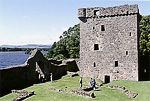 On
an island in Loch
Leven reached by ferry from Kinross off the M90. Tel: 01786 450000 On
an island in Loch
Leven reached by ferry from Kinross off the M90. Tel: 01786 450000
Mary Queen of Scots endured nearly a year
of imprisonment in this 14th-century tower before her dramatic escape in
May 1568. During the first War of Independence it was held by the
English, stormed by Wallace and visited by Bruce.
The Island fortress of Loch Leven Castle
probably takes its name from the eleven rivers flowing into the Loch.
The Island itself is said to have been four times smaller than it is at
present, which would mean that the waters of the loch would almost have
reached up to the Castle walls.
The Castle first appears in the 1290ís
as an English fortification, possibly of wood, on the island during King
Edward I of Englandís attempts to hammer the Scots. However, some time
before 1305 William Wallace attacked the island fortress at night
killing all thirty English men and their five women.
The Castle was still in Scottish hands in
1313 when Robert the Bruce visited the Castle. In fact Robert the Bruce
was the first to use it as a state prison incarcerating the rebel John
of Lorn there in 1316.
In 1335 the castle was attacked by the
English Governor of Edinburgh Castle, however, the castle was stoutly
defended by the governor Alan Vipont and John Douglas of Dalkeith, whose
descendants were to become Lords of the Castle right up to the
seventeenth century.
Around 1350 the stone tower house was
added to the island and later a stone courtyard wall.
After the Battle of Carberry on the 15th
June 1567 Mary, Queen of Scots, surrendered to the rebel lords and was
sent to be a prisoner at the island Castle for almost a year. With the
help of young William Douglas, Queen Mary escaped on the 2nd May 1568.
Shortly after her escape she rallied her supporters but was decisively
defeated at the Battle of Langside.
In 1672 the Castle was sold to Sir
William Bruce of Balcastie, who was designer of the reworking of
Holyrood House for Charles II. In 1690 Bruce built Kinross House on the
mainland and abandoned the island castle which then fell into disrepair. |
